Leverage the 10 Best Game Design Software in 2025
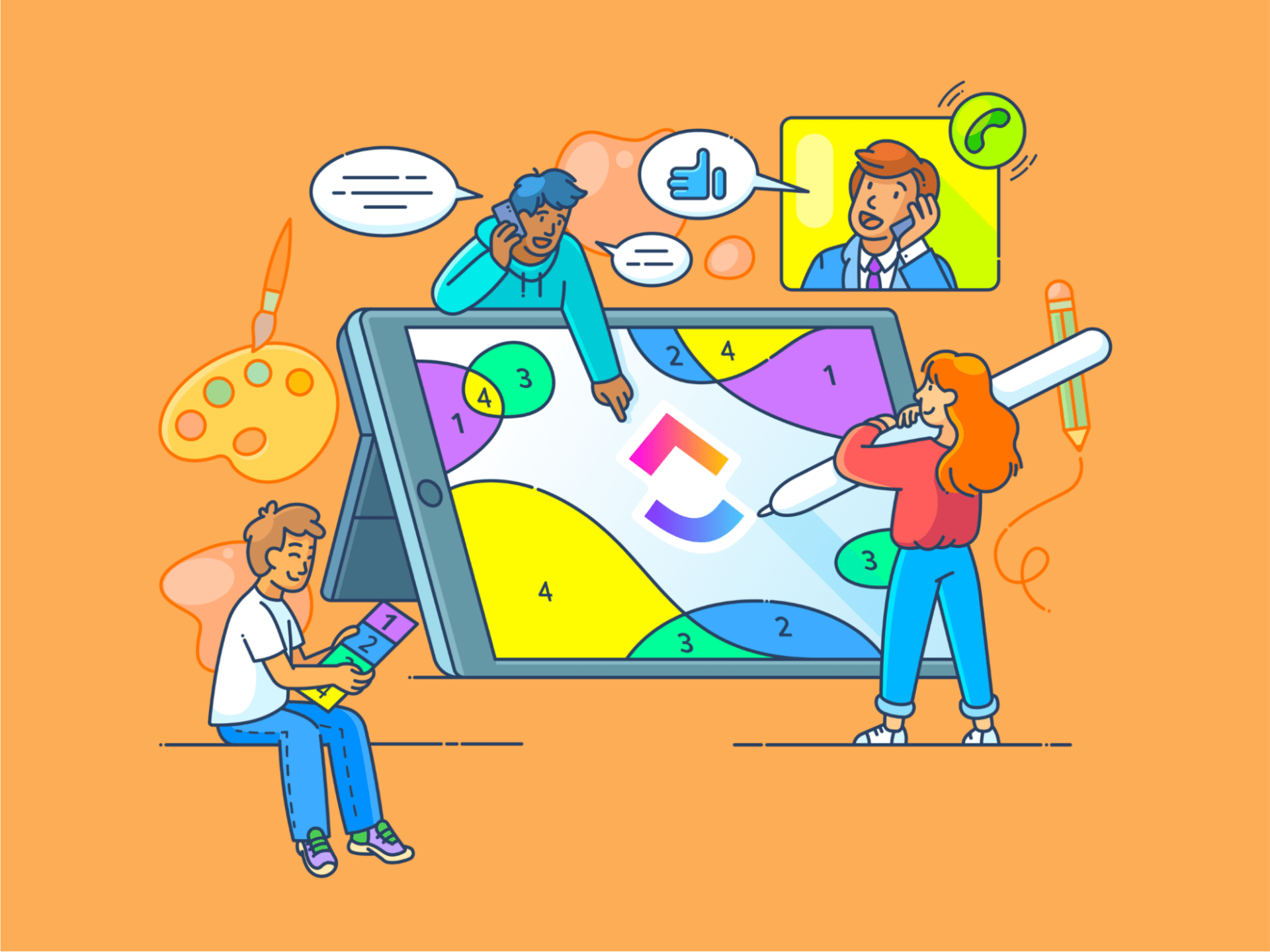
Sorry, there were no results found for “”
Sorry, there were no results found for “”
Sorry, there were no results found for “”
Ever had a game concept simmering in your mind for ages? Imagine bringing that idea to life! Nowadays, the power to create your own video game is at your fingertips, even if you’re not a coding wizard. ?
Still, developing a successful digital gaming product is no walk in the park. It requires thorough planning, team collaboration, and a deep understanding of your player base and engagement prospects. But game creators never shy away from a challenge, do they?
Luckily, you’ll find plenty of game design software tools to efficiently plan, build, test, and deploy all kinds of video games across genres.
We’ve gathered the top 10 game design software solutions to supercharge your creative brainstorming, create stunning designs, and turn your gaming dreams into pixelated realities.
Game design software encompasses essential tools for planning and shaping a video game’s concept, structure, mechanics, deployment, and management. It facilitates brainstorming, documentation, and prototype creation for game designers.
Game development software, on the other hand, is more about turning design blueprints and concepts into fully playable games.
Most game creation solutions support both design and development. Here are some prominent characteristics to look for in a desirable application:
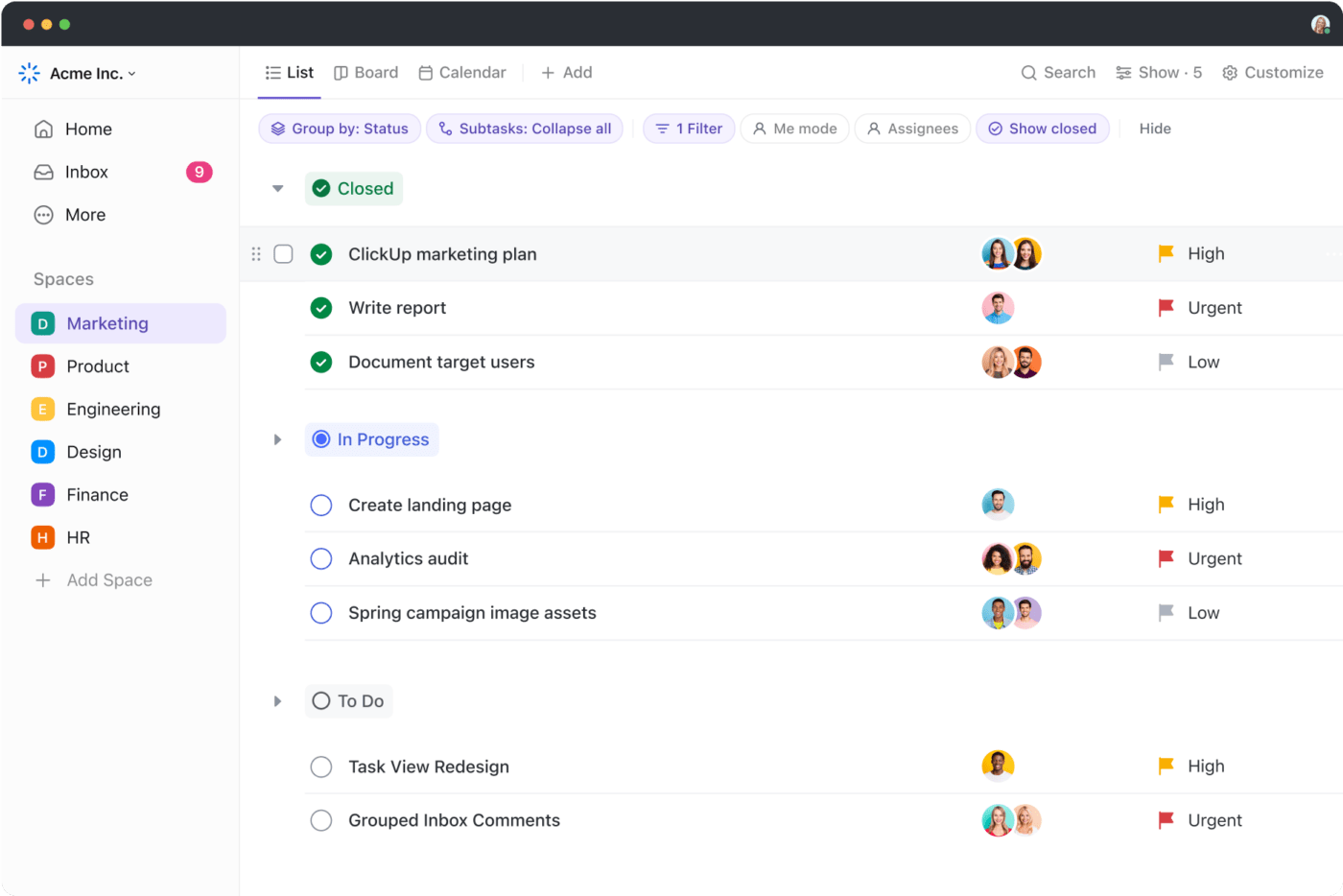
We’re here with a selection of the best game design software to make your creative journey smoother than a joystick glide. ?️
Let’s check out their best features, limitations, and pricing options.

ClickUp is the ultimate all-in-one powerhouse for streamlining game design and development projects. This user-friendly software helps you plan out, track, and execute every step of the project to perfection. ✨
The platform boasts a comprehensive suite of features to oversee the entire project lifecycle. Get your design team onboard on ClickUp Whiteboards and simplify collaborative brainstorming through customizable canvases, Mind Maps, UML diagrams, sticky notes, media items, and project roadmaps.
Turn Whiteboard objects into ClickUp Tasks with a single click, or save them to your knowledge base as ClickUp Docs. The platform’s Chat view is excellent for team conversations through threaded discussions, emojis, comments, and mentions.
Another creative tool you’ll love is the ClickUp AI, an all-purpose writing assistant that generates video game content ideas, deployment timelines, scripted interactions or NPC dialogues, and more!
With ClickUp templates, you can get all types of blueprints for game design, concept mapping, development, and deployment. For instance, try the ClickUp Game Design Document Template to:
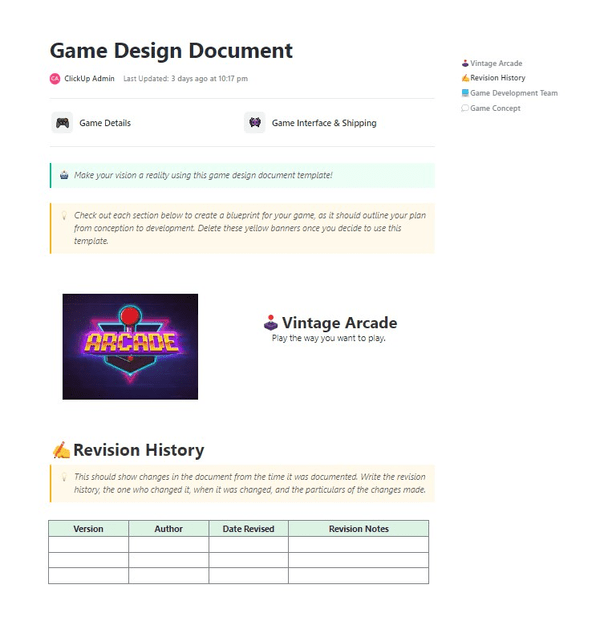
ClickUp doubles as an efficient product management tool. Encourage team transparency by arranging real-time feedback and workflow proofing and keep your collaborators aligned on project objectives. Thanks to ClickUp Sprints, you can streamline your backlogs and optimize the decision-making process before the game launch.
Gain a holistic view of game development workflows on ClickUp Dashboards, a customizable space with 15+ views and reporting tools.
*All listed prices refer to the yearly billing model

Construct 3 is a game development tool suited for those with no coding experience. It offers a fully GUI-driven interface for drag-and-drop game creation.
Although the tool doesn’t require programming, it lets you delve into JavaScript for more advanced game development. Create a playable version of your concept in no time with rapid prototyping.
Construct 3 is tailor-made for crafting straightforward 2D games. Game designers use the tool to incorporate 3D elements into games by using Z elevation to manipulate the vertical position of 2D objects or layers on the Z-axis. Elevate your work by using 3D mesh distortion and adjusting the vanishing point to match your artistic vision. ?️
Transition seamlessly from game design to animation using the Timeline Bar and use the Scene Graph to establish object hierarchies that enable synchronized movement, scaling, and rotation.
*All listed prices refer to the yearly billing model
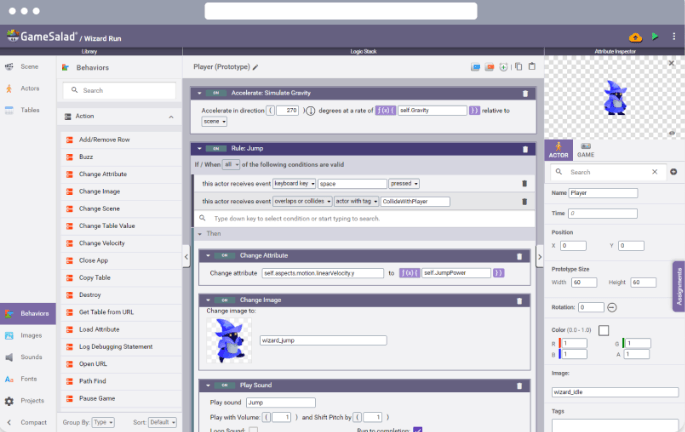
Shift from player to creator mode effortlessly with GameSalad, a user-friendly game design software for crafting 2D video game development. ?
It empowers anyone, regardless of coding experience, to bring their gaming ideas to life. Create your first game within hours with simplified drag-and-drop and one-click features that speed up game development. This accessibility makes GameSalad an excellent educational tool for teaching the basics of game design.
GameSalad boasts key features such as the In-App Previewer for testing game logic and behaviors. It supports cross-platform publishing on various devices, including iPhone, iPad, Android, Kindle, Nook, Windows 8, and Mac. Plus, developers can instantly publish games to the HTML5-powered GameSalad Arcade.
*All listed prices refer to the yearly billing model
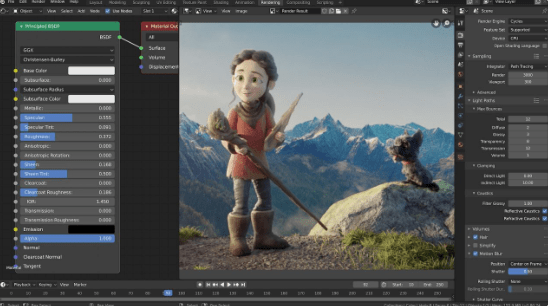
If you’re on the hunt for free 3D modeling software, Blender is your knight in shining armor! ?️
It’s among the best open-source 3D modeling tools, offering a complete suite of capabilities for modeling, animation, rendering, compositing, and motion tracking at no cost.
Blender goes beyond modeling and animation with its Simulation feature, allowing users to create various effects like smoke, fire, and fluids. Other unique tools include Grease Pencil for 2D animation and a rendering engine for ultra-realistic visuals.
You also get access to video editing and VFX features, such as a built-in compositor and camera tracking, making it an all-in-one solution for 3D content creation and post-production.
Additionally, Blender has a customizable interface with adjustable layouts, colors, sizes, and fonts. Harness the power of hundreds of community-created add-ons or craft your own using Blender’s user-friendly Python API.
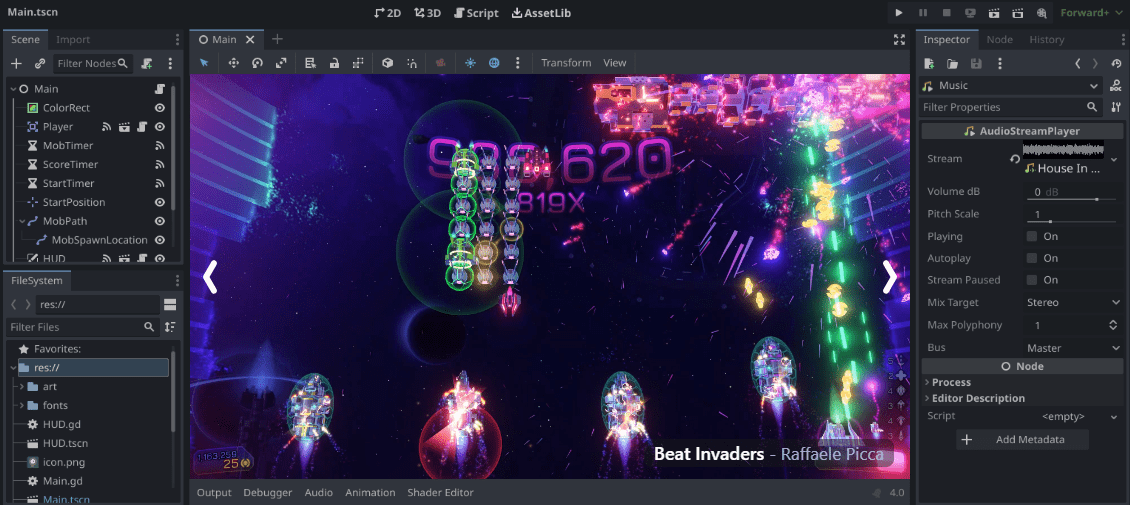
Godot is the game engine you’ve been waiting for, whether you’re a rookie or an experienced programmer. It’s entirely free and open source under the MIT license. ?
The Godot engine is versatile, supporting the creation of both 2D and 3D games. What sets it apart is its meticulous focus on 2D design from the very start, leading to improved performance, fewer glitches, and a more streamlined workflow.
The software uses a distinctive scene-based approach to design, where each “scene” combines game elements like sprites, sounds, and scripts. Nest your scenes or create a hierarchy for easy organization and editing.
Godot’s user-friendly drag-and-drop system and built-in scripting tool called GDScript (similar to Python’s) make the platform easy to follow for beginners.
Additionally, Godot allows customization and optimization for specific projects, provided you have a solid grasp of C++.
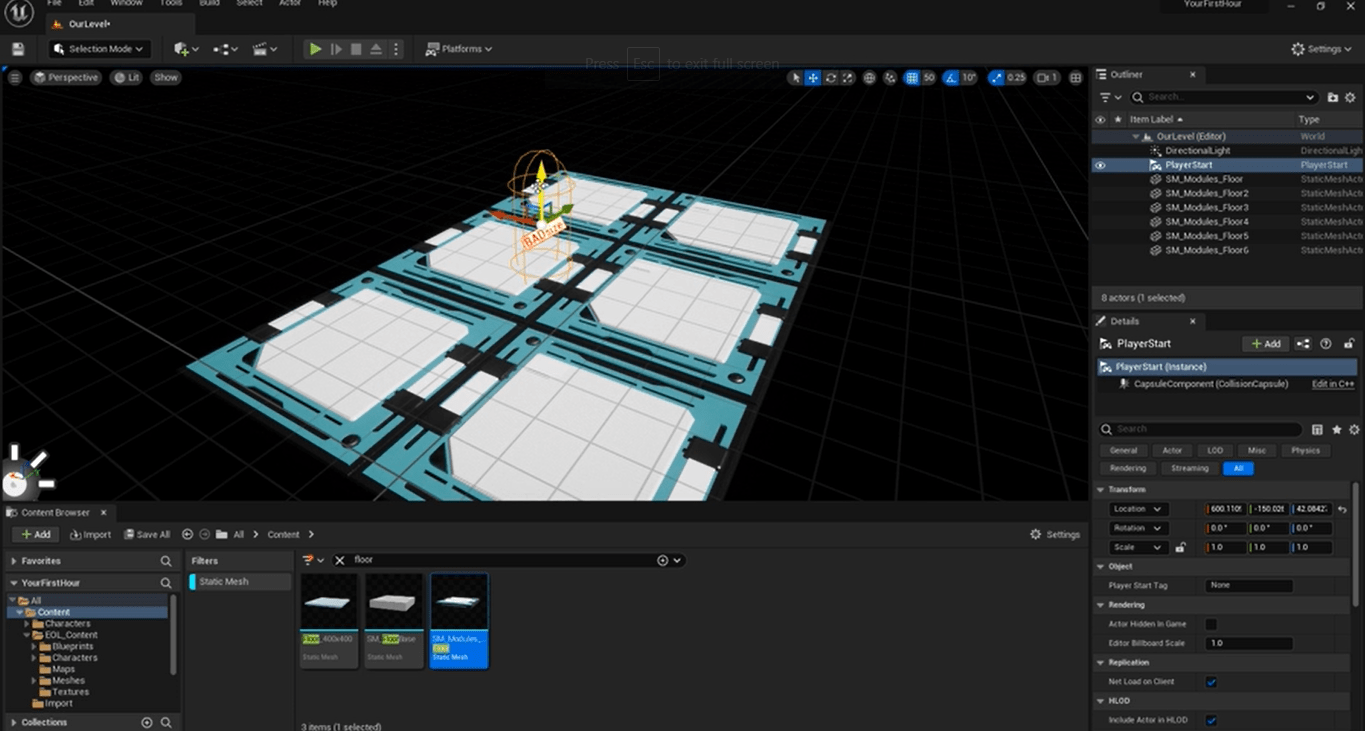
Unreal Engine, developed by Epic Games, is a game design software that reigns supreme in the world of AAA game studios. It has powered successful titles like Fortnite, BioShock, Borderlands, and Dishonored. ?
The solution offers features like hot reloading, instant game previews, cinematic tools, post-processing effects, AI support, and an extensive library of assets. With the MetaHuman plugin, you can create high-quality digital humans with hair and clothing, including eight levels of detail for next-gen gaming character realism.
It offers stunning visual content with physically based rendering, dynamic shadows, realistic reflections, powerful lighting tools, and a flexible material editor.
Unreal Engine provides free access to its complete C++ source code, allowing users to study, customize, expand, and debug the engine. Its scalable and proven client/server architecture enhances the setup of multiplayer projects.
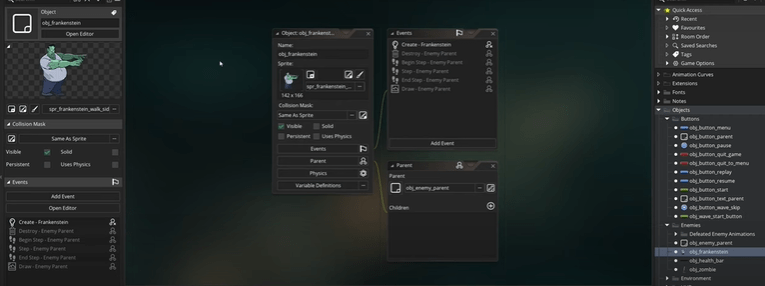
GameMaker is a versatile tool that welcomes everyone to its creative playground, from beginners and indie creators to seasoned professionals. ?
It features an intuitive visual scripting system for those who prefer not to code while also offering programming options for further customizations. Choose between GML Code or Visual options to create 2D games. You also get tools for programming, level design, sound, and compilation.
The Room Editor feature comes with options for enabling physics simulation, managing design tools, and setting camera controls. Create personalized objects through Object Editor, and rearrange your workspace to suit your project.
Unleash your creativity by making or importing your own backgrounds, character animations, and sprites, or use the Image Editor feature to edit and manage personal 2D game assets.
GameMaker has numerous advanced features like source control in-app purchases, multiplayer networking, and third-party extensions.
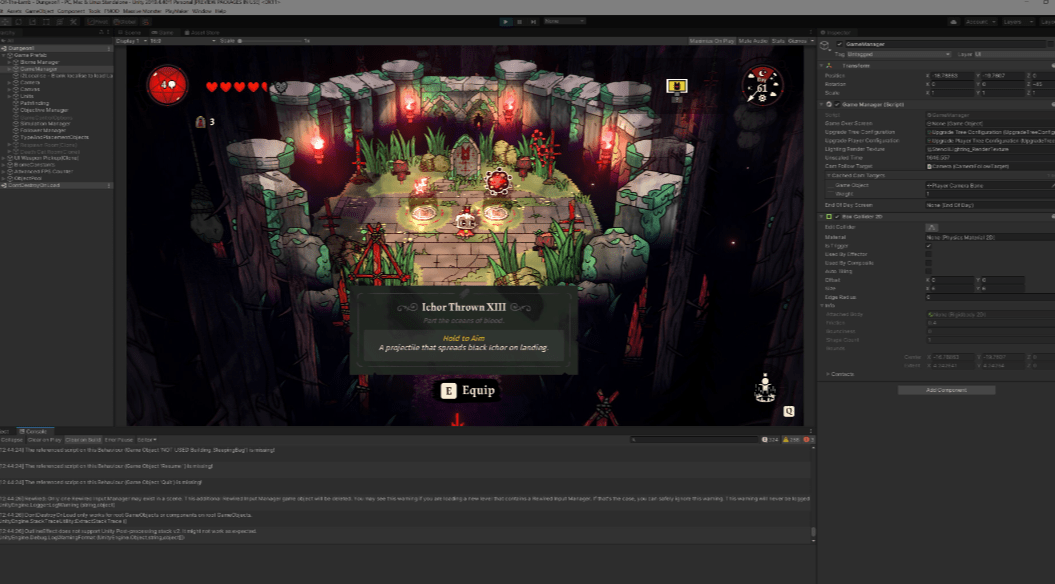
Unity takes the spotlight as one of the most widely used game design solutions, implemented in crafting popular titles like Among Us Valheim, Assassin’s Creed: Identity, and Escape From Tarkov. ❤️?
Unity sets you up with valuable assets for the UX design process and enables the creation of both 2D and 3D games compatible with a wide range of platforms, including Windows, Mac, iOS, Android, Oculus Rift, Steam VR, PS4, and Switch.
Creative teams can collaborate seamlessly within the same environment, facilitating rapid iteration. Whether it’s worldbuilding, animation, cinematics, or rendering, Unity Editor harmonizes effortlessly with tools such as Maya or Blender.
Unlike some alternatives on this list, Unity requires coding skills, so proficiency in C# is essential to fully leverage its capabilities. For those with limited programming experience, the platform offers extensive beginner-friendly tutorials and educational resources.
*Yearly plans must be prepaid

Allegro is a cross-platform library designed for programming video games and multimedia applications. While not a full-fledged game engine, it offers a flexible foundation for developers to customize programs. It primarily handles common, low-level tasks such as window creation, user input processing, data loading, image rendering, and sound playback.
Independent game developers with limited resources use Allegro to focus on creative game design without extensive research and development. Larger teams may leverage it as a stable base to streamline their game engine development and stabilize a project.
Although Allegro is intended for C and C++, it can also be used with other programming languages.
Wwise is your scalable audio sidekick in the game development space, offering various design and development tools to bring your audio vision to life. ?
This software offers creative freedom through dynamic mixing options that efficiently manage sound priority and processing. Wwise Spatial Audio excels at creating immersive environments since it specializes in virtual acoustics, sound propagation, and spatially informed audio rendering.
Wwise allows musical cues to adapt based on rules for the best segment playback. Plus, sound designers benefit from a variety of built-in synthesizers, enabling crisp and diverse sound generation.
*Paid plans are one-time purchase options
Game designing can be exciting and intimidating at the same time! Bring ambitious concepts to life with the help of our listed game development software solutions.
If your project requires heavy brainstorming and conceptualizing work, give ClickUp a shot! Leverage its visualizing and collaborative features to birth your next creative vision. ⭐
© 2026 ClickUp